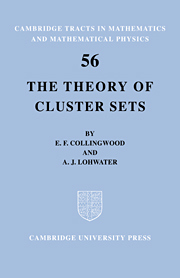Book contents
- Frontmatter
- Contents
- Preface
- Chapter 1 INTRODUCTION
- Chapter 2 FUNCTIONS ANALYTIC IN A CIRCULAR DISC
- Chapter 3 TOPICS IN THE THEORY OF CONFORMAL MAPPING
- Chapter 4 INTRINSIC PROPERTIES OF CLUSTER SETS
- Chapter 5 CLUSTER SETS OF FUNCTIONS ANALYTIC IN THE UNIT DISC
- Chapter 6 BOUNDARY THEORY IN THE LARGE
- Chapter 7 BOUNDARY THEORY IN THE SMALL
- Chapter 8 FURTHER BOUNDARY PROPERTIES OF FUNCTIONS MEROMORPHIC IN THE DISC. CLASSIFICATION OF SINGULARITIES
- Chapter 9 PRIME ENDS
- Bibliography
- Index of symbols
- Index
Preface
Published online by Cambridge University Press: 06 November 2009
- Frontmatter
- Contents
- Preface
- Chapter 1 INTRODUCTION
- Chapter 2 FUNCTIONS ANALYTIC IN A CIRCULAR DISC
- Chapter 3 TOPICS IN THE THEORY OF CONFORMAL MAPPING
- Chapter 4 INTRINSIC PROPERTIES OF CLUSTER SETS
- Chapter 5 CLUSTER SETS OF FUNCTIONS ANALYTIC IN THE UNIT DISC
- Chapter 6 BOUNDARY THEORY IN THE LARGE
- Chapter 7 BOUNDARY THEORY IN THE SMALL
- Chapter 8 FURTHER BOUNDARY PROPERTIES OF FUNCTIONS MEROMORPHIC IN THE DISC. CLASSIFICATION OF SINGULARITIES
- Chapter 9 PRIME ENDS
- Bibliography
- Index of symbols
- Index
Summary
This book is intended as an introduction to the theory of cluster sets, and as such does not claim to be comprehensive. Thus, we have had to be selective and omit some things we should have liked to include, but the space available in a Cambridge Tract is limited, and the theory continues to grow.
The founder of the theory was Painlevé who, in 1895, first gave a name—that of domaine d'indétermination—and the status of a distinct mathematical notion to the set of limit points of function at a boundary point of its domain of definition. This set is now called the cluster set of the function at the point in question. Although it arose in connexion with analytic functions the notion is applicable to more general mappings and situations and gives rise to a theory which is essentially topological. Applied, as it has been for the most part, to problems in the theory of functions, it forms a chapter in the expanding field of Topological Function Theory. While this is our main theme and point of view, we have tried not to lose sight of the more general background.
When this book was planned there was no other on the subject available, and the need for an organized account seemed obvious. However, K. Noshiro's book Cluster Sets in the ‘Ergebnisse’ series appeared at about the time when the first draft of our book was finished.
- Type
- Chapter
- Information
- The Theory of Cluster Sets , pp. ix - xiiPublisher: Cambridge University PressPrint publication year: 1966



